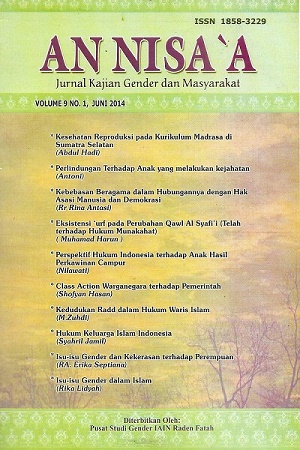KESEHATAN REPRODUKSI PADA KURIKULUM MADRASAH DI SUMATERA SELATAN
Main Article Content
Abstract
Reproductive health curriculum that has yet to be fully implemented, especially in the madrasah whose numbers until now about 58,439 units all over Indonesia. The main reason has not been integrated reproductive health curriculum that still occurs due to the pro and contra opinions of the scholars about the boundaries and standards of teaching materials that will be taught. One local newspaper in Palembang featuring reader letters describes the concerns about the dangers of global development of adolescent reproductive health. Therefore knowledge about reproductive health must be given to teenagers so they do not fall in free sex, pregnancy outside marriage which would have a negative impact for families and communities.
ملخص: مناهج الصحة الإنجابية التي لم تنفذ بالكامل، وخاصة في المدارس الدينية التي حتى الآن حوالي 58,439 وحدة في جميع أنحاء اندونيسيا الأرقام. السبب الرئيسي لم يتم دمج المناهج الصحة الإنجابية التي لا تزال تحدث بسبب الآراء المؤيدة وكونترا العلماء حول حدود ومعايير المواد التعليمية التي سيتم تدريسها. إحدى الصحف المحلية في باليمبانج يضم خطابات القارئ يصف المخاوف بشأن مخاطر التنمية العالمية للصحة الإنجابية للمراهقين. ولذلك يجب أن تعطى المعرفة حول الصحة الإنجابية للمراهقين حتى لا تقع في حرية ممارسة الجنس، والحمل خارج إطار الزواج مما سيكون له تأثير سلبي على الأسر والمجتمعات المحلية.
Article Details

An Nisa'a by http://jurnal.radenfatah.ac.id/index.php/annisa is licensed under a Creative Commons Attribution-ShareAlike 4.0 International License.
How to Cite
References
Arief, Kushartati, (2002). Remaja, Kesehatan Reproduksi, dan Pendewasaan Usia Perkawinan, Dinas Pendidikan Nasional RI.
Blanc, A. and Way, (June 1998). “A. Sexual Behavior, Contraceptive Knowledge and Use”. Studies in Family Planning.
Browne, D., Winkler, G., and Bodenstein, M. (2006). Teaching about HIV and AIDS in the Caribbean. Oxford: Macmillan.
Cash, K. and Anasuchatku, B. (1995). “Experimental educational interventions for AIDS prevention among Northern Thai single female migratory adolescents”. Women and AIDS Program Research Report Series. Washington, D.C.: International Center for Research on Women
Djiwandono, Sri Esti, (2001), Menjawab Pertanyaan-Pertanyaan Anak Anda Tentang Seks, Jakarta : Grasindo.
Fatimaningsih, Endry, (2008) “Analisis Situasi dan Kondisi Perempuan dalam Perspektif Gender di Kabupaten Lampung Tengah”, Prosiding, UNILA.
Fakih, Mansour, (2001). Analisa Gender dan Transformasi Gender, Pustaka Pelajar, Yogyakarta.
Gage, A. (June 1998). “Decision Making Regarding Sexual Activity And Contraceptive Use”. Studies in Family Planning.
Gail, Webber and Spitzer Denise (2010), “Sexual And Reproductive Health Issues Facing Southeast Asian Beer Promoters: A Qualitative Pilot Study”, BMC Health Services Research, Volume:10 No:144.
Grunseit, A. and Kippax, S. (1993). Effects of sex education on young people's sexual be¬havior, Geneva: Global Program on AIDS, World Health Organization.
Hingsburger, Dave. (1990). I Contact—Sexuality and People with Developmental Disabilities, Mountville, PA: VIDA Publishing.
International Council on Management of Population Programmes (ICOMP), (1997). Adolescents/youth reproductive health hazards. Feedback.
Ibnu Qayyim (1411 H), al-Thibb an-Nabawi, Aleppo : Dar al-Way, Cet. XIV
International Center for Research on Women (ICRW) (1996). Vulnerability and Opportunity: Adolescents and HIV/AIDS in the Developing World. Washington, DC.: ICRW.
Isabel, Goicolea, et.al., (2010), “Adolescent Pregnancies and Girls' Sexual And Reproductive Rights In The Amazon Basin Of Ecuador: An Analysis Of Providers' And Policy Makers' Discourses”, BMC International Health and Human Rights. Volume:10 Issue:1 No:12.
Lukman, A.J., dan Hasmi, E. (2004). Remaja Hari ini adalah Pemimpin Masa Depan. Jakarta: BKKBN dan UNICEF.
Madani, Yusuf, (1316 H / 1995 M), al-Tarbiyyah al-Jinsiyyah li al-Athfâl wa al-Bâlighîn, Beirut, Libanon: Dar al Mahajjah al-Baydha.
Mihaela, (2010). “Social Exclusion at the Crossroads of Gender, Ethnicity and Class. A View through Romani Women’s Reproductive Health”, BMC International Health and Human Rights. Volume:10 No:12.
Melberg Schwier, Karin, and Hingsburger, Dave. (2000). Sexuality: Your Sons and Daughters with Intellectual Disabilities. Baltimore, MD: Brookes Publishing
Mitchell S. Tepper (2001). “Becoming Sexually Able: Education to Help Youth with Disabilities”. SIECUS Report, February/March 2001.
Nugraha, Boyke Dian, (2000), Problem Seks dan Cinta Remaja, Jakarta: Bumi Aksara.
PATH (Program for Appropriate Technology in Health), Jurnal Volume 16, 2000, “Kesehatan Reproduksi Remaja:Membangun Perubahan Yang Bermakna “ UNFA.
The Alan Guttmacher Institute (AGI). (May 1998). Into a New World: Young Women's Sexual and Reproductive Lives. New York: AGI.
UNICEF, (2010). “UNICEF at Vienna International AIDS Conference: Children and Young People in Focus at AIDS 2010 Conference”. Press release http://www.unicef.org/media/media_55229.html.
UNESCO Jakarta (2008), “Compedium, Agreements, Laws and Regulations Guaranteeing all Children Equal Rights to Quality Education in an Inclusive Setting: Education Sector to HIV and AIDS: HIV/AIDS Impact on Education Clearinghouse (4.02-SP1)”, http://hivaidsclearinghouse.unesco.org/ev.php.
UNFPA. (1997). UNFPA and Adolescents. New York: UNFPA
Wrobel, Mary (2003). Taking Care of Myself: A Hygiene, Puberty and Personal Curriculum for Young People with Autism. Arlington, TX: Future Horizons
WHO. “Programming for Adolescent Health and Development”. Report of the WHO/UNFPA/UNICEF Study Group on Programming for Adolescent Health. Geneva: WHO (in press).
Yves, Lafort, et al., (2010), “Reproductive Health Services for Populations at High Risk of HIV: Performance of a night clinic in Tete province, Mozambique”: http://www.doaj.org/doaj.
Zabin, L. and Kiragu, K. (June 1998). “Health consequences of adolescent sexuality and fertility behavior in sub-Saharan Africa”. Studies in Family Planning.

